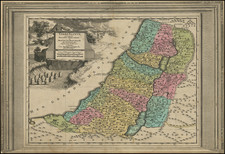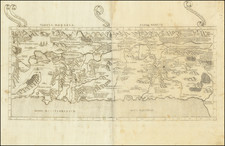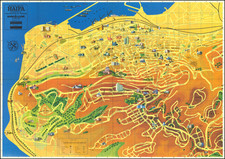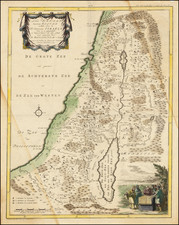Speed's Map of Canaan, Used for the King James Bible. The Defining English-Language Map of the Holy Land.
Very rare and important example of Speed's map of Canaan, being the only edition to be used only in the King James Bible. It represents an apex of Speed's mapping, used in a book with influence "greater than that of any literary movement in our annals, or any religious movement since the coming of St. Augustine" (PMM, 114).
Bound in as part of Speed's Genealogies that were included in the KJV, this is one of the great English-language maps of the Holy Land. The geography significantly updates Speed's 1595 wall map of Canaan, known in one example at the National Library of Israel, which was the first map Speed ever published. In fact, the map may be based on a now-unknown 20-sheet map of the Holy Land, initially designed by John Moor and referenced only in two advertisements.
The geographical rendition of the Holy Land is marvelous. The map relies on the most advanced biblical study of its day, tracing millennia of writing history into this narrow land at the end of the Mediterranean. This leads to a remarkable depth of references on the maps. To name but a few, the reader sees Sodom, Gomorrah, and the other three Cities of the Plain immersed in the Dead Sea - with a single, lone pillar southwest of Sodom. In the Sinai, the Twelve Tribes are shown camped around the Temple. Moses, of course, crosses the Red Sea and frees the land of its serpents.
The map's wonder does not stop with its geography. The upper left includes a detailed map of Jerusalem, bounded by its walls. It is unusual to see a map of Jerusalem this early, rather than a view. Again, here, the details are great - Judas hangs outside the walls and the three crosses stand on Mount Calvary.
The King James Version
The King James Bible has often been called the most important text printed in English. G. M. Trevelyan (Regius Professor of History, Cambridge, and former Trinity College Master) says that "for every Englishman who had read Sidney or Spenser, or had seen Shakespeare acted at the Globe, there were hundreds who had read or heard the Bible with close attention as the words of God." PMM 246 (first edition numeration) says that the work "assert[s] its unrivaled influence on the minds, and still more on the language, of the English-speaking peoples."
"The only literary masterpiece ever to have been produced by a committee" was begun in January 1604 when King James convened the quarreling members of the Church of England to Hampton Court to resolve their feud. John Reynolds, President of Corpus Christi College, Oxford, suggested that a new translation was needed for the bible, which received the full support of the King. Over the next seven years, fifty translators organized into six groups produced the work. The workers relied on earlier English Bibles, including the "Bishops' Bible," 1572 edition, and the Latin Catholic translation of Rheims in 1582. Regardless, they supplemented this with Hebrew and Greek texts, and made what was the most learned vernacular translation of a bible of that day. It was published in 1611 in an erroneous first edition (with "He" in Ruth 3:15) and reissued shortly thereafter in a second, corrected edition. The book was copied and reissued many times over, and continues to be the standard English-language text.
The folio editions of the KJV had a genealogical addendum composed by Speed, into which the map of Canaan was affixed.
Editions of the Speed Canaan
There are two folio-sized editions of Speed's map of Canaan, which have two major differences. The edition used solely in the KJV has horizontally-engraved waves and credits "Renold Elstrack." The edition that appears both in the KJV and Speed's Prospect has a stippled sea and an additional cartouche advertisement above "Anno Domina 1611."
Otherwise, the two editions have the same geography. The stippled edition was apparently the only edition used in the first edition He KJV, while later editions of the KJV, namely the "Great She Bible," use both editions interchangeably. It is unclear when the present edition started to be used in KJV bibles, although it is known to predate 1617. All issues of Speed's Prospect use the stippled edition.
John Speed (1551 or '52 - 28 July 1629) was the best known English mapmaker of the Stuart period. Speed came to mapmaking late in life, producing his first maps in the 1590s and entering the trade in earnest when he was almost 60 years old.
John Speed's fame, which continues to this day, lies with two atlases, The Theatre of the Empire of Great Britaine (first published 1612), and the Prospect of the Most Famous Parts of the World (1627). While The Theatre ... started as solely a county atlas, it grew into an impressive world atlas with the inclusion of the Prospect in 1627. The plates for the atlas passed through many hands in the 17th century, and the book finally reached its apotheosis in 1676 when it was published by Thomas Bassett and Richard Chiswell, with a number of important maps added for the first time.











![Paradise or the Garden of Eden With the Countries circumjacent Inhabited by the Patriarchs [shows Cyprus]](https://storage.googleapis.com/raremaps/img/small/84459.jpg)
![Turquie en Asie [Shows Cyprus]](https://storage.googleapis.com/raremaps/img/small/87678.jpg)

